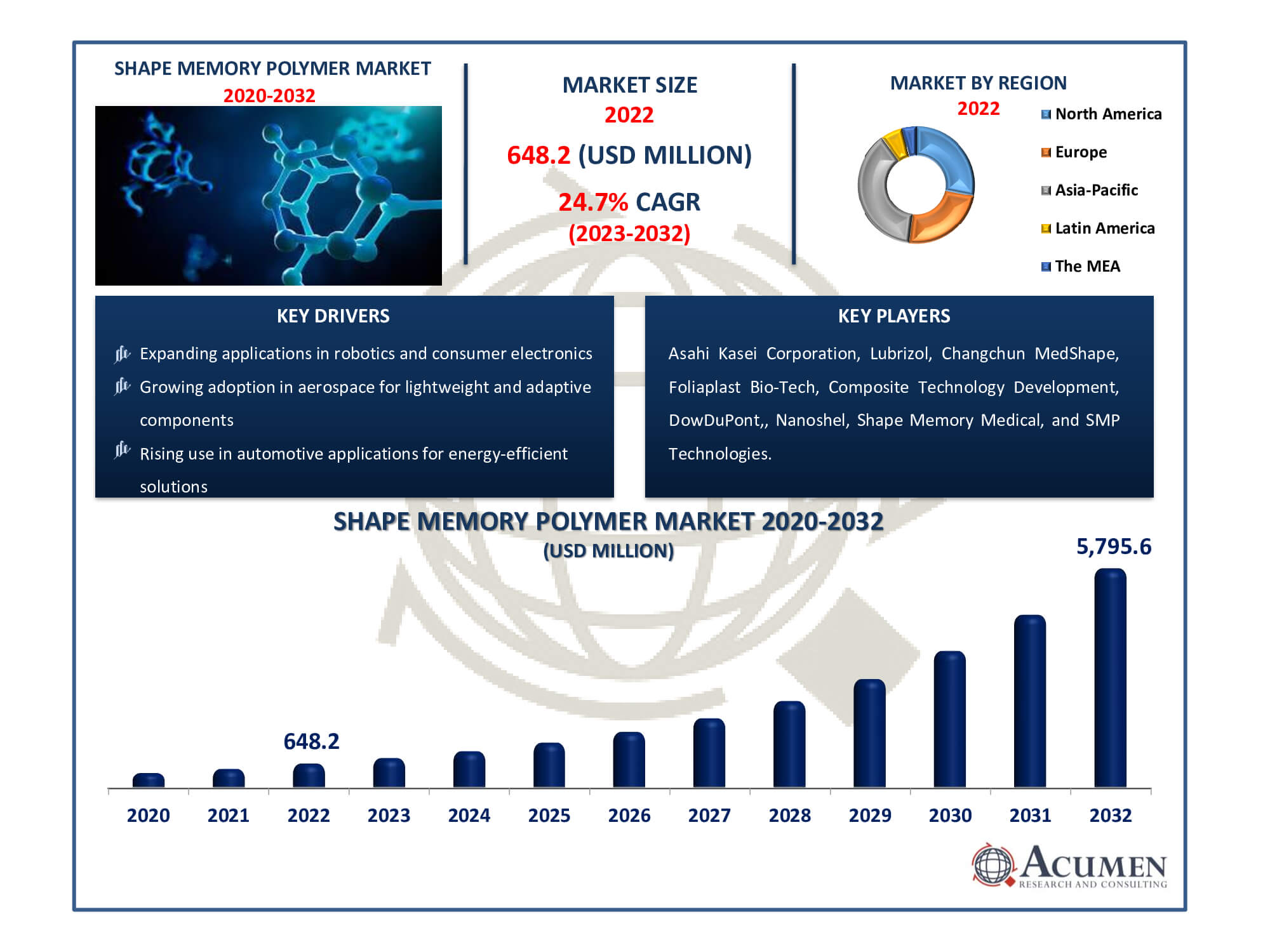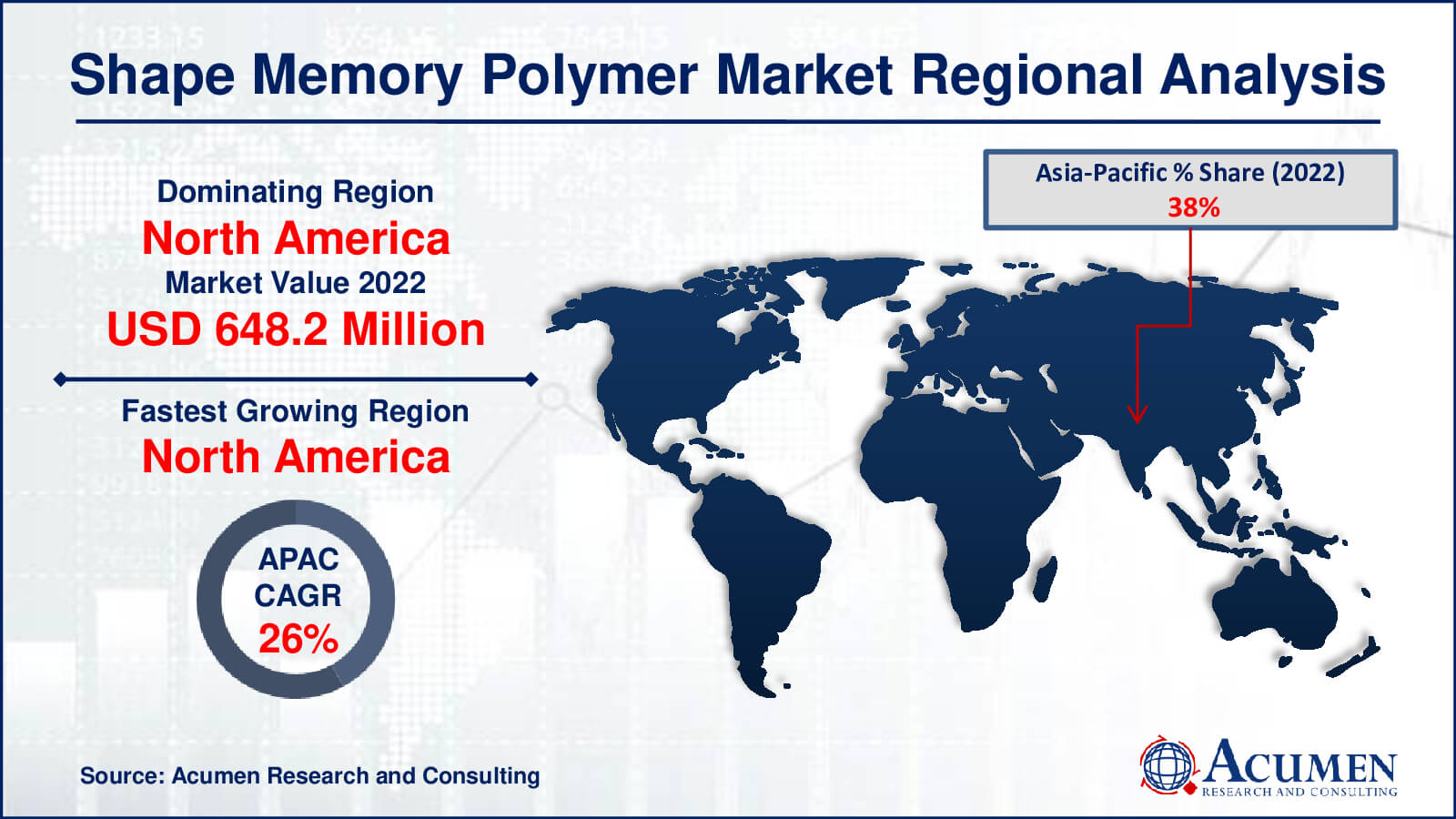April 2023
Shape Memory Polymer Market Size accounted for USD 648.2 Million in 2022 and is estimated to achieve a market size of USD 5,795.6 Million by 2032 growing at a CAGR of 24.7% from 2023 to 2032.
The Shape Memory Polymer Market Size accounted for USD 648.2 Million in 2022 and is estimated to achieve a market size of USD 5,795.6 Million by 2032 growing at a CAGR of 24.7% from 2023 to 2032.
Shape Memory Polymer Market Highlights

A shape memory polymer is a smart polymeric material that can return from a temporarily distorted state to its original permanent state when triggered by an external stimulus, such as temperature, force, a magnetic field, light, chemicals, and more. The polymer is initially formed into a permanent shape through conventional methods, after which it is deformed into the desired temporary shape using a process called programming. This material offers numerous advantages, including low density, lightweight, excellent shape recovery, and ease of processing. Shape memory polymers can be custom-tailored for use in a wide range of applications, including biomedical, automotive, aerospace, construction, materials, and more.
Shape memory polymers can undergo a significant transformation by using heat or other stimuli to convert from a rigid polymer into a flexible state. They return to their 'memory' shape when the stimulus is removed. Moreover, SMPs can withstand up to 200% elongation without material degradation, allowing them to be stretched, folded, or molded into various shapes due to their flexibility. The quality of the product is derived from the stored mechanical energy formed during the reconfiguration and cooling of the raw material.
Global Shape Memory Polymer Market Dynamics
Market Drivers
Market Restraints
Market Opportunities
Shape Memory Polymer Market Report Coverage
| Market | Shape Memory Polymer Market |
| Shape Memory Polymer Market Size 2022 | USD 648.2 Million |
| Shape Memory Polymer Market Forecast 2032 | USD 5,795.6 Million |
| Shape Memory Polymer Market CAGR During 2023 - 2032 | 24.7% |
| Shape Memory Polymer Market Analysis Period | 2020 - 2032 |
| Base Year |
2022 |
| Forecast Data | 2023 - 2032 |
| Segments Covered | By Material, By Application, By End-User, And By Geography |
| Regional Scope | North America, Europe, Asia Pacific, Latin America, and Middle East & Africa |
| Key Companies Profiled | Asahi Kasei Corporation, Changchun Foliaplast Bio-Tech, Composite Technology Development, Cornerstone Research Group, DowDuPont, EndoShape, Guangzhou Manborui Materials Technology Company, Lubrizol, MedShape, Nanoshel, Shape Memory Medical, and SMP Technologies. |
| Report Coverage |
Market Trends, Drivers, Restraints, Competitive Analysis, Player Profiling, Covid-19 Analysis, Regulation Analysis |
Shape Memory Polymer Market Insights
A key driving factor for the shape memory polymers market is the increasing demand in the automotive and aerospace industries. Actuators and sensors made from SMPs are employed in vehicles to replace hydraulic systems or small electric motors. Actuators derived from shape memory polymers enhance vehicle performance, fuel efficiency, and reduce component size. Ongoing research into SMP utilization for manufacturing vehicle seats will further boost product demand in the automotive sector in the coming years.
The major drivers of the shape-memory polymers market are their growing applications in the healthcare sector and the rising construction industry in Asia-Pacific countries, such as India and China. However, as the shape-memory polymers market is growing, certain drawbacks limit its growth, such as relatively low stiffness values. The development of improved manufacturing techniques enables the mass production of cross-linked SMP devices, which would otherwise be cost-prohibitive when made using traditional thermoset polymerization methods.
One of the key application areas for the shape memory polymer market that will witness significant growth in the future is the biomedical industry. The product has been found to be non-toxic, biocompatible, and non-mutagenic, allowing its use in various medical devices implanted in the human body. Shape memory polymers are used to manufacture various types of catheters that can be rigid for easier control by a physician while remaining soft inside the human body. The product is also used to produce orthopedic supports and braces, intravenous cannulas, surgical casts, sutures, and stents. An attractive feature of SMPs that will drive their biomedical applications is the ability to tailor their glass transition temperature for shape restoration or self-alignment of medical devices when inserted or in contact with the human body. These features, along with advancements in shape memory technology, will drive product demand for biomedical applications and boost the overall market during the forecast period.
In the automotive industry, these advanced materials are utilized in vehicle subsystems that can self-heal when damaged or can be designed to change their color or appearance. This innovative material offers new cutting-edge features while enhancing vehicle performance at a lower cost.
The first commercial use of shape memory polymers occurred during the 1960s when covalently cross-linked polyethylene was employed in packaging films and heat-shrinkable tubing. However, for these applications, other polymeric materials began replacing polyethylene SMPs. The period from 1980 to 2010 witnessed numerous patents and research activities aimed at developing SMPs for a wide range of applications, including doll hair, landscape designs, utensils for individuals with disabilities, smart materials, and even sportswear. Research and development of SMP materials for industrial use has also gained momentum over the past three decades. These development activities will have a significant impact on the shape memory polymer industry, as many materials are likely to become commercialized in the near future, driving product demand for various applications.
Shape Memory Polymer Market Segmentation
The worldwide market for shape memory polymer is segmented into material, application, end-user, and geography.
Shape Memory Polymer Materials
According to industry analysis of shape memory polymers, polyurethane is the largest material segment, expected to grow at a CAGR of approximately 26% from 2023 to 2032. The significant growth and a larger market share of this segment can be attributed to the increasing development of polyurethane-based shape memory polymers and their extensive use in biomedical applications.
Epoxy-based SMP materials are likely to experience a growth rate of over 21% CAGR during the forecast period due to their rising utilization as engineering materials. Epoxy-based polymers exhibit excellent properties such as processability and thermomechanical characteristics. They show a remarkable response to stimuli, high deformation and recovery ratios, as well as a rapid and adjustable recovery process. The market for these materials will be driven by their increasing use in deployable structures for the aviation industry and as actuators in the automotive sector.
Shape Memory Polymer Applications
The research and development segment of the shape memory polymers market was valued at USD 450 million in 2022 due to increasing investments by market participants in SMP research. However, the segment's growth rate is expected to be relatively lower as the commercialization of SMP products that are still in the research phase will increase by the end of the forecast period. On the other hand, the business segment is likely to experience high growth during the forecast period due to the increasing number of shape memory polymer products entering the market in the coming years.
Research and development will have a significant share of the overall market in the initial period of the forecast period. However, the segment is expected to lose market share by 2025 due to several materials in the research phase becoming commercialized.
Shape Memory Polymer End-Users
According to the shape memory polymer market forecast, the biomedical sector is expected to be the largest end-use segment in the market. The quantity of commercially available SMP-based medical products is projected to increase significantly in the coming years, which will drive the overall market during the forecast period.
The aerospace industry utilizes shape memory polymers due to their high stability, deformability, and lightweight properties. The increasing growth in the aerospace sector in developed countries, such as the U.S., is likely to boost demand for SMPs in the upcoming years. Additionally, the rising space exploration activities will also contribute to increased product utilization in the manufacturing of various spacecraft components and parts.
Shape Memory Polymer Market Regional Outlook
North America
Europe
Asia-Pacific
Latin America
The Middle East & Africa

Shape Memory Polymer Market Regional Analysis
North America is a key market for shape memory polymers, expected to grow at a CAGR of over 26% from 2023 to 2032. The region's dominant position can be attributed to the presence of several SMP manufacturers and experts in the U.S., along with a large number of patents filed in the country. The utilization of SMPs in aviation and space technology will also offer ample opportunities for market growth in North America during the forecast period.
The Asia-Pacific is set to become a significant market by the end of the forecast period, with expected growth of around 27% CAGR from 2023 to 2032. Increasing automotive production rates in countries such as China, India, and other Asian nations, along with a rising interest in aviation and space exploration activities, will drive this demand. The manufacturing of biomedical devices in China and South Korea will also play a key role in the growth of the Asia-Pacific market in the coming years.
Shape Memory Polymer Market Players
Some of the top shape memory polymer companies offered in our report include Asahi Kasei Corporation, Changchun Foliaplast Bio-Tech, Composite Technology Development, Cornerstone Research Group, DowDuPont, EndoShape, Guangzhou Manborui Materials Technology Company, Lubrizol, MedShape, Nanoshel, Shape Memory Medical, and SMP Technologies.
Looking for discounts, bulk pricing, or custom solutions? Contact us today at sales@acumenresearchandconsulting.com
April 2023
September 2024
May 2023
August 2023